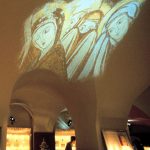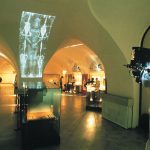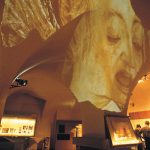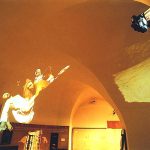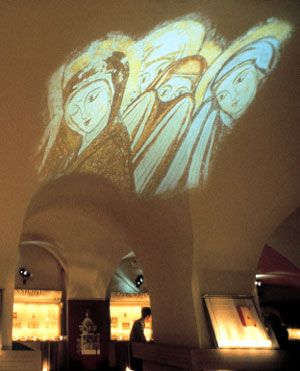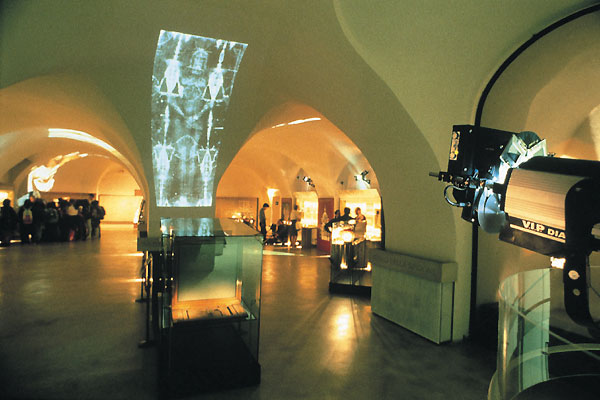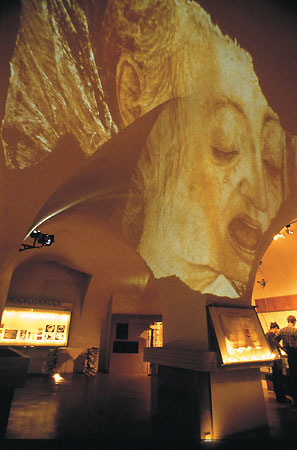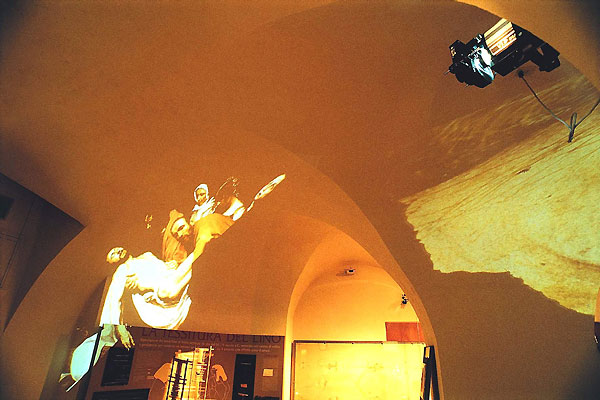16 Clay Paky V.I.P. DIAs have been installed in this museum in Turin to mark out a descriptive and spiritual path of the Holy Relic
The Shroud is the funeral sheet in which Jesus was wrapped when he had been taken down from the Cross. Since it arrived in Turin, as long ago as 1578, over the years it has become the subject of numerous studies and, even though full of enigmas and mysteries which remain unsolved even today, (the marking of the body impressed on the sheet reproduces a perfect image in “photographic negative”), the Shroud undoubtedly holds a charismatic attraction for the Christian Community throughout the world. Its Presentation in 1998 in view of the Jubilee has in fact drawn millions of the faithful to Turin, and the Pope’s visit on 24th May has further underlined the solemnity of this event.
A stopping place which is not to be missed during the “pilgrimage” of the faithful is also the “Museo della Sindone” (the Museum of the Shroud), where one can follow the various phases of the history of the sheet and the scientific research studies which have investigated its image. This permanent museum, which was founded in 1936, presents some interesting novelties this year in its presentation to the public: amongst these is the use of Clay Paky Display Line projectors, 16 V.I.P. DIAs to be precise, which create a background of light which blends in perfectly with the character of the setting.
The LD Ricky Ferrero, author of the entire project, explains how he came to this decision: “For some time I had been thinking about enriching the Museum with something “creative”: it seemed a good idea to project images of religious subjects on the walls, creating a sort of descriptive route which is spiritual at the same time. But I needed to find the right product capable of creating an effect which would be pleasing to the visitors without being too intrusive …” Ricky explains the project to Luca Baraldo, the lighting operator, who, during his visit to SIB in Rimini, finds what he is looking for at the Clay Paky stand. A few days later Ricky and Luca meet up with Light Video Sound, the Clay Paky retailer for the Turin area, to sort out the project. Ricky is extremely satisfied: “Clay Paky’s V.I.P. DIA not only offers me the possibility of projecting three slides in succession, but guarantees me a whole series of performance possibilities which you cannot find in other similar products”.
“The first of all of these – he continues – is that the V.I.P. is a very elegant product which can be suitably adapted to a museum setting where the aesthetic of “beautiful” is in force: it is in no way cumbersome, it does not have unattractive wires, its reduced dimensions mean it can be placed everywhere.
Secondly, it guarantees me a reliability and resistance in time which are second to none: just think that our night watchman at the museum, who did not know how to work the lighting system, left the projectors switched on 24 hours a day for 20 days non-stop! Following this tour de force we changed the bulbs and could note that the projectors, even having been subjected to a long non-stop period of stress, were still completely integral.
I was surprised by the number of accessories the Display Line proposes: fixed and rotating mirrors, prisms and all sorts of special effects offer infinite possibilities to play with the light, creating narrative messages and codes which can be different every time.
Finally, the V.I.P.s are very quiet and so perfect to be used in places such as museums or churches where a solemn silence reigns.”
Ricky chooses 16 V.I.P. DIAs for the Museum, 9 of which with a 150 Watt halogen bulb and 7 with an HTI 150 Watt bulb. The choice of low power bulbs is intentional so that the effect is a soffusion of light which is complementary to and does not disturb the holy objects in the museum. All the V.I.P.s are assembled with a gradual dimmer and are equipped with a “multiple timer” , a device which was “invented” by Clay Paky for the occasion so that the movement of the dimmer and the change of slide can be synchronised; in this way the beam of light can be covered at the exact moment that the change of image occurs. “The Display Line products – says Ricky – demonstrated their flexibility of use straightaway, thanks also to the Clay Paky technical staff who have succeeded in carrying out my ideas to perfection. When you work with a company who collaborates with you and together you can study the best solutions to adopt, this leads to a great feeling of trust and the certainty that you are doing things in the best possible way”.
But what type of images are projected in the museum?
“The slides that are mounted on the V.I.P.s – adds Luca Baraldo – have been obtained from religious paintings. The images have been re-processed by computer and then cut so that they can be adapted to the dome-shaped ceilings of the museum. In some cases, the images have been superimposed and projected onto two different architectural elements (for example, the walls and the ceiling above). The projection beam can be direct or reflected by the mirror, so that even the most hidden corners of the rooms can be easily reached.”
During the period of the Presentation of the Shroud, the Museum hosts parties of visitors who come from all over the world, who stop to look at the projected images with curiosity and interest, proving that these new proposals in architectural lighting are greatly appreciated. The two designers conclude, saying “The lighting of buildings and monuments is in great expansion, since a whole series of prejudices has disappeared, prejudices which wanted these places to be imperturbable and immaculate. Now there are huge possibilities for growth both from the point of view of technical innovation and artistic experimentation: we already have a lot of projects in this sector!”.
The current period of Presentation at the Cathedral in Turin will last until 15th June. The Museum will instead remain open with its usual opening times and will continue to host thousands and thousands of people in the name of a spiritual and religious symbol which is of extraordinary importance.
